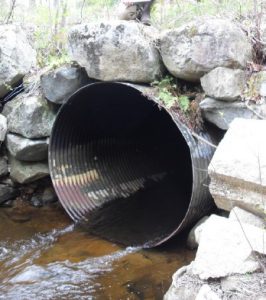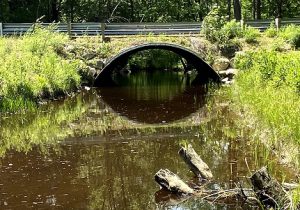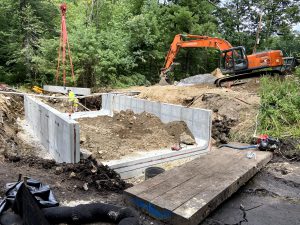Activities that involve excavation, filling, dredging, or construction that will occur within, or on the banks or shoreline of wetlands and surface waters, generally require review and approval from the New Hampshire Department of Environmental Services Wetlands Bureau in accordance with the Fill and Dredge in Wetlands Act (RSA 482-A).
In 2010, NHDES first adopted rules for permitting stream crossings and the Wetlands Bureau regulates the installation, replacement, or repair of stream crossings under RSA 482-A and Chapter Env-Wt-900. The purpose of the Chapter 900 rules is establish standards for stream crossing design that will enhance public safety and lessen flood risks, preserve the important functions and values of New Hampshire’s streams, support restoration efforts, and improve aquatic connectivity for fish and wildlife.
All new stream crossings, and modifications to existing stream crossings, must be designed to maintain or enhance:1) Geomorphic Compatibility, 2) Hydraulic Capacity, and 3) Aquatic Organism Passage.


This old, metal pipe culvert (left photo) was undersized for the stream and could not properly transport water and sediment downstream, often overtopping the road during storm events. The crossing was replaced with a 26′ open-bottom pipe arch that is much larger, provides sandy, cobble sediment throughout, and can accommodate the 100-year storm event. By replacing the deficient pipe with this fully-compliant structure, a flood and safety issue has been addressed and 15-miles of cold water tributaries are now accessible to brook trout and other aquatic wildlife.
Please read the NHDES Fact Sheet and the New Hampshire Stream Crossing Guidelines to learn more about design requirements to support flood resiliency and improve stream connectivity in New Hampshire. The Wetland Permit Application Stream Crossing Worksheet is an excellent guidance document to help engineers, consultants, and permittees compile the data needed to meet the NHDES requirements. For tidal crossings, additional analyses and data on the crossing are required; please refer to the Coastal Area Worksheet for more information.

If you have a project that will result in dredge, fill, or other impacts to a stream channel or banks, freshwater or tidal wetland, shoreline, or other jurisdictional area please visit the NHDES Wetlands Bureau Permitting Assistance page for more information on how to obtain the necessary permits for the work.
Contact the NHDES Wetlands Bureau by phone at (603) 271-2147 or email at lrm@des.nh.gov.